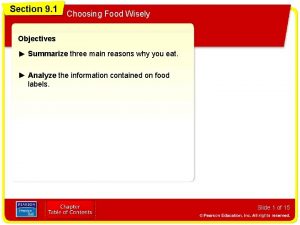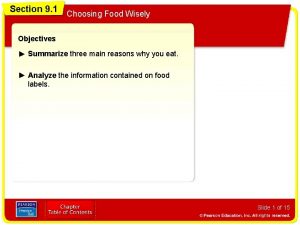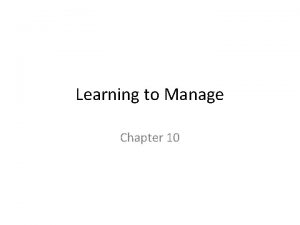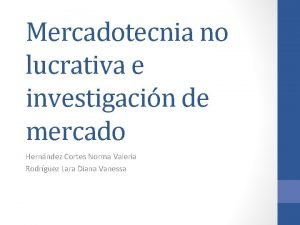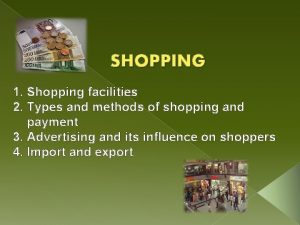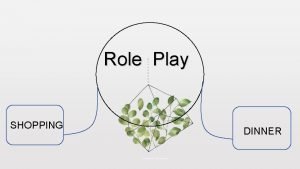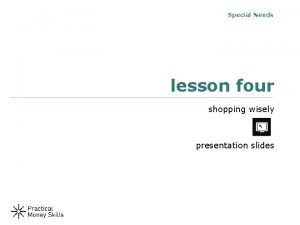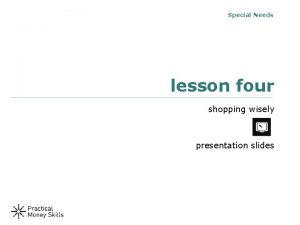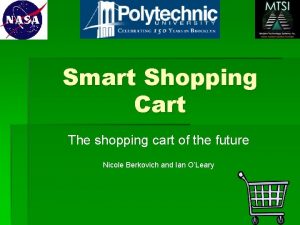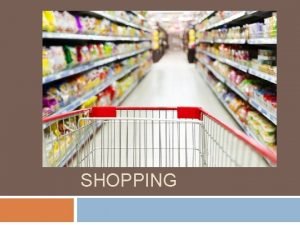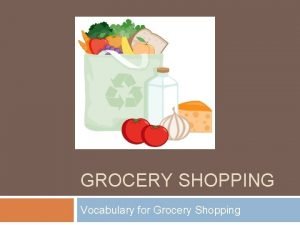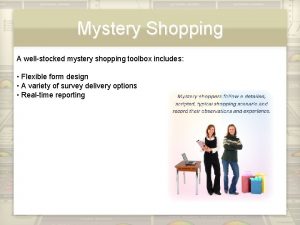Chapter 26 Shopping Wisely Shopping Outlets What I


























- Slides: 26

Chapter 26: Shopping Wisely – Shopping Outlets

What I Will Learn • To describe and evaluate the different types of shopping outlets • To differentiate between self-service and counter service shops • To discuss the changes in shopping in recent years

Consumer Awareness Activity Let’s see how aware you have become as a consumer. Read the case studies and answer the questions. Case study 1 Gerry bought a washing machine in his local electrical shop. A month later when he washing a load of clothes, he noticed a pool of water on the floor. He went back to the shop to complain but the salesperson told him that he had to contact the manufacturer to get it sorted. See Activity 26. 1 in the TRB

Consumer Awareness Activity (continued) Case study 1: Questions 1. Is the salesperson correct? 2. What should John do next? 3. As John, write a letter of complaint to the shop manager stating the problem and what you expect to be done about it. See Activity 26. 1 in the TRB

Consumer Awareness Activity (continued) Case study 2 Melissa and June received a voucher for a local hotel to use their pool and relaxation room, so they set off for a lovely relaxing day. After her swim, Melissa went into the shower and pressed the automatic ‘on’ button. Boiling hot water hit her back and she jumped away and fell, twisting her ankle. The attendant was quite rude when June went to get help; she said that the water was never too hot so Melissa must have been careless when getting out. They then asked to see the manager. The attendant told Melissa that the manager was away but she would tell him when he got back. Mary and Jane left to go to the doctor to get her back and foot examined.

Consumer Awareness Activity (continued) Case study 2: Questions 1. What should Melissa do next? 2. As Melissa, write a letter of complaint to the hotel manager stating the problem and explain what you expect to be done about it.

Shopping Wisely • Shopping is part of everyday life. • The way we shop has changed over the years and there is greater choice now. • However, there is a temptation to overspend and waste resources, so we need to become responsible and ethical shoppers. • We must learn to distinguish between what we want and what we need.

Shopping Outlets Small independent shops • Traditional small shops, often family-run and sometimes open long hours. • They may offer less choice and can be more expensive. • They may provide a more personal service, like a delivery service and often offer a line of credit.

Shopping Outlets (continued) Specialist shops Usually specialise in one type of stock, e. g. shoes, books or jewellery.

Shopping Outlets (continued) Supermarkets • Large open-plan grocery shops. • They are self-service and usually easy to move around in. • They have a wide variety of goods from food and cleaning products to clothing and electricals, and offer their own brands alongside other brands. • Some offer internet shopping with home delivery, loyalty cards and special offers for regular customers. • Supermarkets are often cheaper than independent stores, as, because of the bigger turnover of stock, they can buy products in bulk, reducing unit costs.

Shopping Outlets (continued) Department stores • Large open-plan shops, that are easy to move around in. • Predominantly self-service, but many offer a personal shopping service too. • They offer a wide variety of products, laid out in separate departments, e. g. make-up, shoes, household, clothing, etc. • They offer good value for money with competitive pricing.

Shopping Outlets (continued) Multiple chain stores • One company with many branches, each with the same layout and style, selling the same products. • Competitive and good value due to bulk buying and shared advertising. • Usually self-service. • Located in large towns, e. g. Penneys, Dunnes Stores, Aldi and Lidl.

Shopping Outlets (continued) Discount stores • Can be part of a chain or independent. • Some are based on catalogue orders while others offer counter service. • They sell cheaper items, pre-packed goods that cannot be examined before purchase, and goods may need to be assembled. • They have limited stock in stores, good returns policies and can offer online ordering for instore pickup, e. g. Argos. • Others focus on a wide array of low-cost items to encourage impulse buying. These have a high turnover and are self-service, e. g. Dealz and Tiger.

Other Shopping Outlets • Street markets • Vending machines • Farmers’ markets • Mail order • Auctions • Shopping centres • Party selling • Teleshopping • Door-to-door selling • Outlet shops • Internet shopping

Online Shopping • • • Advantages Easy to use, wide variety of websites can be accessed quickly Easy to compare brands prices and styles Goods can be bought from home, anytime day or night, making it more convenient May be cheaper as easy to compare prices Next day delivery and order tracking is offered by some companies • • • Disadvantages Increased risk of impulse buying and overspending which can lead to debt The product may not be as expected as you cannot examine the product or try it on As a credit card is needed, there is a higher risk of credit card fraud online Delivery can take a long time Postage charges can add to the cost of products

Shopping Activities Think-Pair-Share 1. One-minute activities a) List as many products as you can that are sold in markets. b) Name as many online shops as you can. c) Name as many different shops as you can that offer a counter service. d) List as many changes in shopping in recent times as you can.

Shopping Activities 2. In pairs, pull a shopping outlet from the box. a) Prepare a poster – on computer or by hand – describing the outlet. b) Give local and national examples. c) Outline the advantages and disadvantages of this type of outlet. d) Explain how this type of outlet affects the environment. e) Put the poster up on a ‘consumer wall’ and talk about it to the class.

From Counter Service to Self-Service • In recent times many shops have moved from counter service to self-service. • In the past, supermarkets were just large outlets where you could buy groceries more cheaply, they were impersonal and provided little choice of fresh foods. • Today, competition between them has improved variety and service greatly.

Counter Service • • Advantages Personal service Easier, especially for older people Usually local, handy if you run out of something May offer credit and free delivery • • Disadvantages May be slow and inefficient More expensive Smaller choice Prices not always visible

Self-Service Advantages • • • Quick and convenient Goods are displayed well and clearly priced Consumers can take their time to browse and select Less expensive (buy in bulk and have lower overheads) Own brands are particularly cheap A quick turnover means fresher produce Greater choice – wide range of products available Easy to examine and compare products Trolleys make it easier to shop in bulk Credit cards or cash can be used

Self-Service (continued) Disadvantages • • Greater temptation to impulse buy Less personal Queues at checkouts, especially at peak times You may have to pack your own groceries Can be difficult to buy small amounts May need a car for out of town shopping Can be difficult for older people to find what they want

How Shopping Has Changed Shopping has changed significantly over the past 50 years • Many small local shops have closed down. • More large shopping centres that offer a ‘one-stop shopping’ experience with many retail outlets. Parking is usually available and free with other facilities such as crèches and restaurants. • Checkouts use barcodes and scanners and many shops have self-service checkouts.

How Shopping Has Changed (continued) • We make less frequent trips to the shop because we buy in bulk, which is more economical. • Opening hours have changed – some shops have online stores, some offer late night and early opening times, and some even have a 24 -hour service. • Payment methods have changed: online and phone buying has increased due to the availability of credit and debit cards. This has also decreased the need for consumers to carry cash, which encourages impulse buying.

How Shopping Has Changed (continued) • Environmental awareness has increased among consumers. The plastic bag levy and electrical recycling charge has forced retailers to become more environmentally aware, choosing fair trade and organic products that appeal to consumers. • A higher awareness of nutrition has led to more detailed labels and increased availability of ‘healthy’ meal options in take-away outlets. • Consumers demand a higher standard of hygiene in retail and food outlets, as they are now aware of the link between poor hygiene and illness.

How Shopping Has Changed (continued) • The increase in the number and variety of retail outlets has led to pricing competition, and more discount shops leads to price wars, e. g. Lidl and Aldi vs. Dunnes and Supervalu. • Consumers are much more aware of their rights and the need to shop around for value for money. • The retail and food industry have adapted products to cater for the variety of cultures living in Ireland.

Quick Revision 1. Describe four types of shopping outlets. 2. Discuss four changes in shopping in recent years.
 Chapter 11 section 4 using water wisely answer key
Chapter 11 section 4 using water wisely answer key We think we are using water wisely because
We think we are using water wisely because Choosing food wisely quiz
Choosing food wisely quiz It is a practice of using resources wisely
It is a practice of using resources wisely Choosing food wisely
Choosing food wisely Wisely using resources to achieve goals is known as
Wisely using resources to achieve goals is known as Iambic pentameter othello
Iambic pentameter othello 4.3 using studies wisely
4.3 using studies wisely Lucrativae
Lucrativae Choosing wisely geriatrics
Choosing wisely geriatrics Helen leathem
Helen leathem As i walk this wicked world
As i walk this wicked world Wisely definition
Wisely definition What is a sentinel outlet
What is a sentinel outlet Radial circuits
Radial circuits Medical gas slide
Medical gas slide Unit 3 chapter 7 bargain shopping
Unit 3 chapter 7 bargain shopping We bought fruit yesterday
We bought fruit yesterday Let's do some shopping
Let's do some shopping Unit 4 let's go shopping
Unit 4 let's go shopping Stfc hate loud music
Stfc hate loud music Chapter 36 apush
Chapter 36 apush Shopping role play
Shopping role play Online shopping presentation
Online shopping presentation Conversation in a shop
Conversation in a shop Shopping facilities examples
Shopping facilities examples Savvy online shopping
Savvy online shopping


